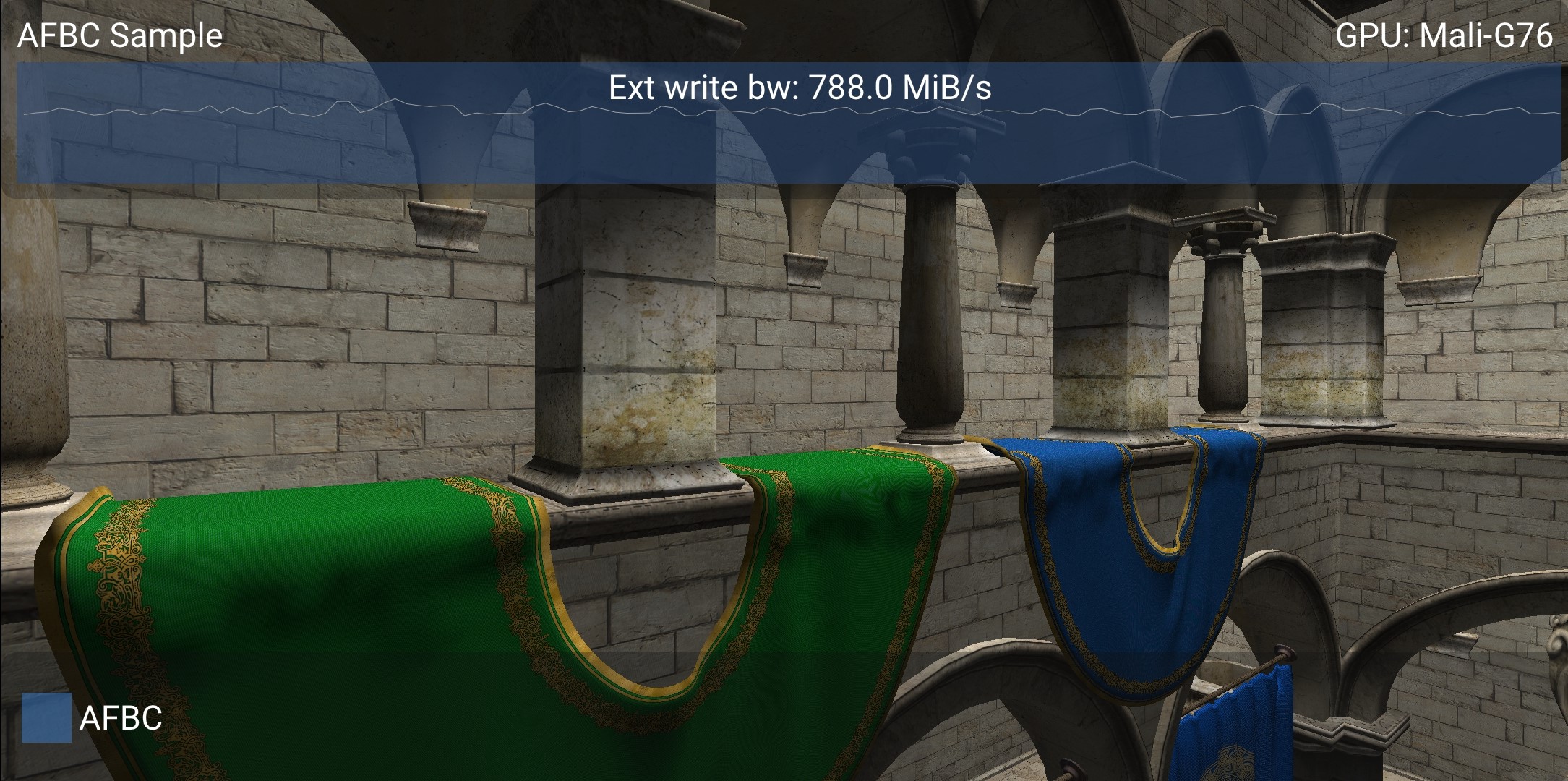vulkan_best_practice_for_mobile_developers
Enabling AFBC in your Vulkan Application
Overview
AFBC (Arm Frame Buffer Compression) is a real-time lossless compression algorithm, designed to tackle the ever-growing demand for higher resolution graphics. This format is applied to the framebuffers that are to be written to the GPU. This technology can offer bandwidth reductions of up to 50%.
The sample is geared towards demonstrating the bandwidth that you can save by toggling AFBC on and off and displaying a real-time graph of the external bandwidth. In this case we will be focusing on the swapchain images.
The Vulkan API allows the developer a level of control around how the VkSwapchainKHR is created and formatted. It is here where we want to ensure that it is created and formatted in the right way so that the subsequent VkImage’s that we query from it have AFBC appropriately applied.
It is important to note that from a device perspective to have AFBC enabled on Vulkan, you will need at least driver version r16p0 and a Mali G-51 or higher. To find out your GPU and driver version, open the debug window or follow the steps in this article.
Tested on: Samsung Galaxy S10, Huawei P30
Enabling AFBC
AFBC is functionally transparent to the application and will be automatically applied on a per VkImage basis (provided multiple checks pass on various properties of your device and your images).
The driver will check the applications state along with the VkImage properties to determine if it will enable AFBC or just continue without it.
This section will detail the requirements.
VkImage requirements:
VkSampleCountFlagBitsmust beVK_SAMPLE_COUNT_1_BITVkImageTypemust beVK_IMAGE_TYPE_2DVkImageTilingmust beVK_IMAGE_TILING_OPTIMALVkFormatsupported list
In addition to this, your VkImage needs to adhere to the following flags:
VkImageUsageFlagsmust not contain:VK_IMAGE_USAGE_STORAGE_BITVK_IMAGE_USAGE_TRANSIENT_ATTACHMENT_BIT- (Only for some devices with driver version
r16p0)VK_IMAGE_USAGE_TRANSFER_DST_BIT
VkImageCreateFlagsmust not contain:VK_IMAGE_CREATE_ALIAS_BITVK_IMAGE_CREATE_MUTABLE_FORMAT_BIT
The AFBC Sample
The sample presents the user with Sponza, with a graph displaying bandwidth at the top and a configuration window at the bottom.
The configuration itself is simple. There is one checkbox (labelled “AFBC”) that will reload the swapchain when its value is changed.

Here the sample is in its default state: AFBC off. At the top of the screen there is a graph displaying the external write bandwidth (measured from L2_EXT_WRITE_BEATS).
It is currently setting the VK_IMAGE_USAGE_STORAGE_BIT flag in the VkImageUsageFlags for the swapchain images, causing the driver to skip over applying AFBC to the swapchain images.
When we enable the check box, the sample will reload the swapchain with the right usage flags to have the driver enable AFBC.

Here is the same scene as before, except AFBC is now enabled. The VK_IMAGE_USAGE_STORAGE_BIT flag is not being set and the swapchain is being created properly.
The bandwidth has dropped from 788.0 MiB/s to 528.6 MiB/s, this is approximately a 33% reduction.
You can also confirm these numbers in Streamline. Here are some screenshots:


Format Support
GPUs from Mali-G77 onwards support formats up to and including 32 bits per pixel regardless of color channel arrangement or sRBG.
Previous generations that support AFBC only support a subset of formats:
| Formats |
|---|
| VK_FORMAT_R4G4B4A4_UNORM_PACK16 |
| VK_FORMAT_B4G4R4A4_UNORM_PACK16 |
| VK_FORMAT_R5G6B5_UNORM_PACK16 |
| VK_FORMAT_R5G5B5A1_UNORM_PACK16 |
| VK_FORMAT_B5G5R5A1_UNORM_PACK16 |
| VK_FORMAT_A1R5G5B5_UNORM_PACK16 |
| VK_FORMAT_B8G8R8_UNORM |
| VK_FORMAT_B8G8R8A8_UNORM |
| VK_FORMAT_B8G8R8A8_SRGB |
| VK_FORMAT_A8B8G8R8_UNORM |
| VK_FORMAT_A8B8G8R8_SRGB |
| VK_FORMAT_A8R8G8B8_SRGB |
| VK_FORMAT_B10G10R10A2_UNORM |
| VK_FORMAT_R4G4B4A4_UNORM |
| VK_FORMAT_R5G6B5_UNORM |
| VK_FORMAT_R5G5B5A1_UNORM |
| VK_FORMAT_R8_UNORM |
| VK_FORMAT_R8G8_UNORM |
| VK_FORMAT_R8G8B8_UNORM |
| VK_FORMAT_R8G8B8A8_UNORM |
| VK_FORMAT_R8G8B8A8_SRGB |
| VK_FORMAT_A8R8G8B8_UNORM |
| VK_FORMAT_R10G10B10A2_UNORM |
| VK_FORMAT_D24_UNORM_S8_UINT |
| VK_FORMAT_D16_UNORM |
| VK_FORMAT_D32_SFLOAT |
Further Reading
- Arm Frame Buffer Compression - developer.arm.com
Best practice summary
Do
- Ensure that your swapchain is created correctly as per the requirements of AFBC.
- Ensure that all textures are compressed into ASTC format.
- Avoid changing your image configuration at run-time (using
vkCmdCopyImagewith an invalid AFBC requirement) as it will trigger a decompression. - Make sure you are resolving your images using
pResolveAttachmentswhen it comes to multisampling. AnyVkImagewithSAMPLE_COUNT > 1will not have AFBC applied to it.
Don’t
- Use image usage flags, such as
VK_IMAGE_USAGE_STORAGE_BIT, unless you really need it (i.e. for compute on a specific image).
Impact
- Having an incorrect configuration of your images will cause all your surface
VkImage’s to be uncompressed, losing out on considerable system wide bandwidth reductions.
Debugging
- To test if AFBC is enabled or disabled, you can use a profiler such as Streamline and record the bandwidth values of when AFBC is enabled or when AFBC is disabled.